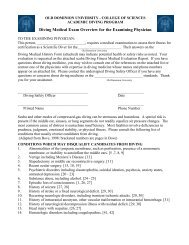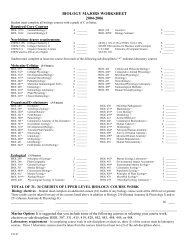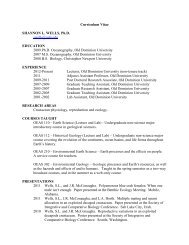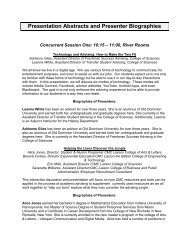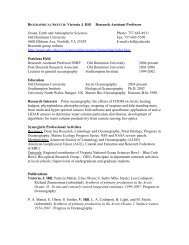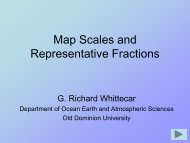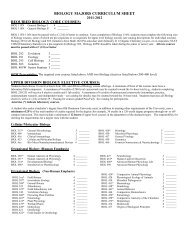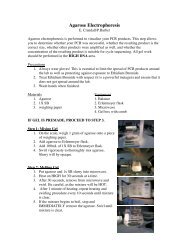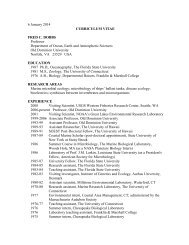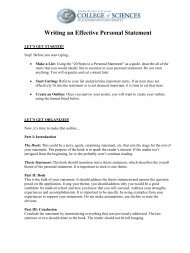Swimming dynamics and propulsive efficiency of squids throughout ...
Swimming dynamics and propulsive efficiency of squids throughout ...
Swimming dynamics and propulsive efficiency of squids throughout ...
You also want an ePaper? Increase the reach of your titles
YUMPU automatically turns print PDFs into web optimized ePapers that Google loves.
2 I. K. Bartol et al.Fig. 1 Illustration <strong>of</strong> squid swimming in a tail-first <strong>and</strong> arms-first orientation. Squids swim by flapping/undulating their fins <strong>and</strong> usinga pulsatile jet, while their arms are important for generation <strong>of</strong> lift <strong>and</strong> for stability control. The dotted <strong>and</strong> solid arrows representthe direction <strong>of</strong> water during mantle refilling <strong>and</strong> mantle contraction, respectively.(flaps) values (Hoar et al. 1994; Bartol et al. 2001b;Anderson <strong>and</strong> DeMont 2005).The dual-mode <strong>propulsive</strong> system affords many<strong>squids</strong> tremendous locomotive flexibility. Usingthis system, most <strong>squids</strong> can achieve high levels <strong>of</strong>maneuverability, having the ability to navigate structurallycomplex habits, hover, change directionquickly, <strong>and</strong> even swim almost vertically in the watercolumn. Squids can reach the fastest speeds knownamong aquatic invertebrates ( 8ms 1 ) (Alex<strong>and</strong>er1977; Vogel 1987), swim arms-first or tail-first(Hanlon et al. 1983; Vecchione <strong>and</strong> Roper 1991;Bartol et al. 2001a, 2001b), elude predators adeptly(Hanlon <strong>and</strong> Messenger 1996), <strong>and</strong> attack fast-movingprey when the system is coupled with rapid-striketentacles (Kier <strong>and</strong> van Leeuwen 1997). Some <strong>squids</strong>,such as the Japanese squid Todarodes pacificus, evenundergo extensive migrations <strong>of</strong> 2000 km, duringwhich they swim continuously at an average speed<strong>of</strong> 0.3 m s 1 (Gosline <strong>and</strong> DeMont 1985).During ontogeny, <strong>squids</strong> undergo critical morphologicalchanges that affect their two locomotivesystems. Squid paralarvae—a term used for cephalopodhatchlings because they do not undergo adistinct metamorphosis like true larvae but dodiffer behaviorally, ecologically, <strong>and</strong> morphologicallyfrom adults (Young <strong>and</strong> Harman 1988; Hanlon <strong>and</strong>Messenger 1996)—have saccular, rounded bodies<strong>and</strong> small, rudimentary fins, forcing hatchlings torely more heavily on the jet than on the fins forpropulsion (Boletzky 1974; Okutani 1987; Hoar et al.1994). Juveniles <strong>and</strong> adults have more streamlinedbodies <strong>and</strong> larger, more developed fins (Hoar et al.1994). Although the fins are <strong>of</strong>ten overlooked inlocomotive studies, the fins play prominent locomotiveroles in many juvenile <strong>and</strong> adult shallow-water<strong>squids</strong> (Hoar et al. 1994; Bartol et al. 2001a, 2001b;Anderson <strong>and</strong> DeMont 2005) <strong>and</strong> are the mostimportant <strong>propulsive</strong> mechanism for many mesopelagic<strong>and</strong> bathypelagic <strong>squids</strong> (Vecchione et al. 2001,2002). Compared with juvenile <strong>and</strong> adult squid,paralarvae also have relatively larger funnel apertures(Packard 1969; Boletzky 1974; Thompson <strong>and</strong> Kier2002), hold a proportionally greater volume <strong>of</strong> waterin their mantle cavities (Gilly et al. 1991; Preuss et al.1997; Thompson <strong>and</strong> Kier 2001a), <strong>and</strong> have shorterthick filaments in the mantle muscles that providepower for jetting (Thompson <strong>and</strong> Kier 2006).As <strong>squids</strong> undergo morphological changes <strong>throughout</strong>development, they also experience very differentflow regimes. Paralarval forms <strong>of</strong> Illex illecebrosus,Sepioteuthis lessoniana, <strong>and</strong> Lolliguncula brevis operateat Reynolds numbers (Re) <strong>of</strong> 1–10 2 whilejuveniles <strong>and</strong> adults operate at Re <strong>of</strong> 10 3 –10 6(O’Dor et al. 1986; O’Dor 1988; Thompson <strong>and</strong>Kier 2002; Bartol et al. 2001b). The giant squidArchiteuthis operates over a particularly wide Rerange from 1 as a paralarva to 10 8 as an adult. Overthe wide Re range <strong>of</strong> <strong>squids</strong>, the physics <strong>of</strong> fluidsplays an important role in shaping swimmingperformance. Within the intermediate Re range <strong>of</strong>paralarvae, both inertia <strong>and</strong> viscosity have similarrelative effects on flow. As a result <strong>of</strong> the prominentrole <strong>of</strong> viscosity at these Re, continuous swimming ismore advantageous than burst-<strong>and</strong>-coast swimming(Weihs 1974). Rapid jetting in paralarvae resemblesburst-<strong>and</strong>-coast swimming since there is a burst <strong>of</strong>thrust as the mantle contracts <strong>and</strong> water is expelled,followed by a coasting phase as the mantle refills.Consequently, more frequent contractions with lesscoasting presumably should be favored in hatchlings.This prediction is consistent with Thompson’s <strong>and</strong>Kier’s (2001a) finding that paralarvae [5 mm dorsalmantle length (DML)] have higher contraction rates<strong>of</strong> the mantle during escape than do juvenile <strong>and</strong>sub-adult (10–65 mm DML) oval squid S. lessoniana.The interplay <strong>of</strong> morphology <strong>and</strong> fluid mechanicsduring ontogeny in <strong>squids</strong> clearly affects swimmingperformance <strong>and</strong> <strong>propulsive</strong> <strong>efficiency</strong>. Few studies,however, have examined swimming performance<strong>and</strong> <strong>propulsive</strong> <strong>efficiency</strong> over multiple life-historystages in <strong>squids</strong>. Using kinematic data, morphologicalmeasurements, <strong>and</strong> flow visualization data,Bartol et al. (2001b) made predictions <strong>of</strong> the relativecontributions to force by the fins <strong>and</strong> jet <strong>and</strong> <strong>of</strong>jet <strong>propulsive</strong> <strong>efficiency</strong> for a size range <strong>of</strong> L. brevis
4 I. K. Bartol et al.are capable <strong>of</strong> swimming in both arms-first <strong>and</strong> tailfirstorientations, the tail-first mode was the focus <strong>of</strong>the current study.Two pulsed ND: YAG lasers (wavelength ¼532 nm; power rating 350 mJ/pulse; LaBestOptronics Co. Ltd., Beijing, China), each operatingat 15 Hz (0.07 ns pulse duration) with a 1–4 msseparation between pulses, were used, together withan optical guide arm, to illuminate the lightreflectiveparticles. The particles were illuminated ina 0.5 mm (using an aperture) or 1–2 mm thickparasagittal plane for paralarval <strong>and</strong> juvenile/adultexperiments, respectively. In all experiments a UNIQUP-1830CL 8 bit ‘‘double-shot’’ video camera(1024 1024 pixel 2 resolution; paired images collectedat 15 Hz; Uniq Vison, Inc., Santa Clara, CA,USA) interfaced with a CL-160 capture card(IO industries, Inc., London, Ontario, Canada) wasused. The camera was positioned orthogonally to thelaser plane to record movements <strong>of</strong> particles aroundthe squid. A VZM 450i zoom lens (Edmund Optics,Barrington, NJ, USA) was used in paralarval experimentsto image flows for FOVs ranging from0.8 0.8 to 2.0 2.0 cm 2 , while a Computar12–36 mm lens was used in juvenile/adult experimentsto image flows for FOVs ranging from 8 8to 14 14 cm 2 . Fine-scale focusing <strong>and</strong> movement <strong>of</strong>the cameras were achieved using a series <strong>of</strong> opticalstages (Optosigma, Santa Ana, CA, USA).In addition to the UNIQ UP-1830CL camera, twohigh-speed DALSA IM150 video cameras (1024 1024pixel 2 resolution; frame rate set at 100 Hz; DALSACorp., Waterloo, ON) outfitted with Fujinon CF25HA-125 mm lenses were used to record motions <strong>of</strong> thebody <strong>and</strong> fins, both for paralarval <strong>and</strong> juvenile/adultexperiments. One camera was positioned underneaththe working section to record images from a ventralperspective <strong>and</strong> the other was positioned directlybeside the UNIQ camera for an exp<strong>and</strong>ed lateral FOV<strong>of</strong> the squid. Because the UNIQ <strong>and</strong> DALSO cameraswere operated at different frame rates, separate lighting,<strong>and</strong> spectral filters were used, depending on thecamera. A series <strong>of</strong> four 40 W lights outfitted with acolor gel #27 filter (transmits wavelengths 4600 nmRosco Laboratories, Inc., Stamford, CT, USA) providedillumination for the high-speed DALSA cameras, whilethe laser light (532 nm) provided the illumination forthe DPIV UNIQ camera. A Kodak Wratten 32 magentafilter (blocks wavelengths 520–600 nm) was mounted tothe DALSA camera lenses to prevent overexposure<strong>of</strong> laser light, <strong>and</strong> an IR filter <strong>and</strong> a Kodak Wratten 58green filter (transmits wavelengths <strong>of</strong> 410–600 nm)were mounted to the UNIQ UP-1830CL camera lensto prevent overexposure from the 40 W halogen lights.The lasers <strong>and</strong> DPIV camera were triggered <strong>and</strong>synchronized using a timing program developed bythe Gharib lab (California Institute <strong>of</strong> Technology,Pasadena, CA, USA), a PCI-6602 counter/timing card(National Instruments, Inc., Austin, TX, USA), <strong>and</strong> aBNC-565 pulse generator (Berkeley Nucleonics Corp.,San Rafael, CA, USA). A 4003A signal generator (B&KPrecision Corp., Yorba Linda, CA, USA) was used totrigger the DALSA cameras at 100 Hz. All cameras <strong>and</strong>the optical laser arm were mounted on a four-axistraverse system (Techno-Isel, New Hyde Park, NY,USA). Using a joystick, a PCI-7344 motion controllerboard (National Instruments), <strong>and</strong> a LabVIEW VI(National Instruments, Inc., Austin, TX, USA), thethree cameras <strong>and</strong> laser arm were moved simultaneouslyalong the traverse to follow the target squid todifferent areas <strong>of</strong> the water tunnel/holding chamber<strong>and</strong> reposition the laser sheet to bisect either the funnelor fin. To avoid inaccurate flow measurements, datawere only collected when the cameras <strong>and</strong> laser armwere stationary.For analysis <strong>of</strong> the DPIV data, each image was subdividedinto a matrix <strong>of</strong> 32 32 pixel 2 interrogationwindows. Using a 16 pixel <strong>of</strong>fset (50% overlap),cross-correlation was used to determine the particledisplacements within interrogation windows comprisingthe paired images using PixelFlow TM s<strong>of</strong>tware(FG Group LLC, San Marino, CA, USA) (Willert <strong>and</strong>Gharib 1991). Outliers, defined as particle shifts thatwere three pixels greater than their neighbors, wereremoved <strong>and</strong> the data were subsequently smoothed toremove high frequency fluctuations. Window shiftingwas performed followed by a second iteration <strong>of</strong>outlier removal <strong>and</strong> smoothing (Westerwheel et al.1997). Using PixelFlow TM s<strong>of</strong>tware, velocity vector<strong>and</strong> vorticity contour fields were determined.Kinematic measurementsMantle contraction <strong>and</strong> refill periods, maximumfunnel diameter (D) during the jet cycle, fin upstroke<strong>and</strong> downstroke periods, displacement during contraction<strong>and</strong> refilling, <strong>and</strong> frame-by-frame swimmingspeeds were measured from lateral DPIV/highspeedvideo footage using the National Institute <strong>of</strong>Health’s public domain program ImageJ (http//rsb.info.nih.gov/ij/) <strong>and</strong> Matlab code written byT Hedrick (University <strong>of</strong> North Carolina, ChapelHill, NC; available at http://www.unc.edu/thedrick/s<strong>of</strong>tware1.html). The mantle <strong>and</strong> funnel orifice werenicely illuminated in the laser sheet, allowing forprecise measurements <strong>of</strong> the mantle <strong>and</strong> funneldiameters.
<strong>Swimming</strong> <strong>dynamics</strong> <strong>of</strong> <strong>squids</strong> 5Calculations <strong>of</strong> impulse, kinetic energy, <strong>and</strong><strong>propulsive</strong> <strong>efficiency</strong>Several Matlab (MathWorks, Inc., Natick, MA, USA)utilities were used to calculate hydrodynamicimpulse <strong>and</strong> kinetic energy, all <strong>of</strong> which assumeaxisymmetry about the axis <strong>of</strong> a shed vortex’s jetcentroid, irrespective <strong>of</strong> whether the jet was producedby mantle contraction or by the fins. First,the slope <strong>and</strong> y-intercept <strong>of</strong> the jet centerline weredetermined, based on a best fit <strong>of</strong> the velocity <strong>and</strong>vorticity data. The length <strong>of</strong> the jet (L) was theextent <strong>of</strong> the velocity field along the jet centerline.Second, using the angled centerline as the r ¼ 0 axis,jet impulse (I ) <strong>and</strong> kinetic energy (E) were computedusing the equations:ZI ¼ ! r 2 drdx ð1ÞjetZE ¼ jetV 2 rdrdxwhere V is the velocity magnitude <strong>and</strong> ! is theazimuthal component <strong>of</strong> vorticity, r is the radialcoordinate, <strong>and</strong> is the fluid density. The areaintegrals were computed using a 2D version <strong>of</strong> thetrapezoidal rule. The effects <strong>of</strong> the velocity fieldaround a vortex (not induced by the vortex itself)were considered to have negligible influence onimpulse calculations because all vortices consideredin our analysis were spaced more than one ringdiameter away from other vortices or boundaries.For juveniles/adults, background flow, i.e., speed <strong>of</strong>the water in the tunnel, was subtracted from the flowvelocity field so that only excess kinetic energy wasmeasured. Third, the components <strong>of</strong> the impulsevector in the vertical <strong>and</strong> horizontal directions werecomputed, based on the slope <strong>of</strong> the jet centerlinerelative to the direction <strong>of</strong> the primary displacement.Because the direction <strong>of</strong> primary displacement wasnot aligned along a horizontal axis in paralarvae, aswas the case for juveniles/adults, it was necessary tocompute a displacement angle using ImageJ. Usingthis displacement angle <strong>and</strong> the jet angle determinedfrom the Matlab routine, the component <strong>of</strong> theimpulse aligned with the direction <strong>of</strong> displacementwas computed for paralarvae.Paralarvae generally do not swim in horizontalpaths through the water column as do juvenile <strong>and</strong>adult squid; instead they swim predominantly upwardduring mantle contraction <strong>and</strong> sink during mantlerefilling, with net vertical displacement determinedlargely by the duration <strong>of</strong> the refill phase. Because workð2Þdone by the <strong>propulsive</strong> system <strong>and</strong> not work done bygravity is <strong>of</strong> interest, the effect <strong>of</strong> gravity on the netmotion was factored out by considering only themotion during jet ejection. Therefore, to compare jet<strong>propulsive</strong> <strong>efficiency</strong> for paralarvae with that <strong>of</strong> olderlife-history stages that swim more horizontally,<strong>propulsive</strong> <strong>efficiency</strong> was computed for only theexhalant phase <strong>of</strong> the jet cycle.The equation used to calculate jet <strong>propulsive</strong><strong>efficiency</strong> during the exhalant phase <strong>of</strong> the jet cyclefor an ontogenetic range <strong>of</strong> squid (paralarvae toadults) was: PðjetÞ ¼~F j x~F j x þ E EJð3Þwhere ~F j ¼ jet thrust time-averaged over the mantlecontraction (N), x ¼ displacement during mantlecontraction (m), <strong>and</strong> E EJ ¼ total excess kineticenergy <strong>of</strong> the jet (J). Time-averaged jet thrust, ~F j ,was determined by dividing the impulse (Ns)component in the direction <strong>of</strong> displacement by themantle-contraction period (s). The impulse used inthis <strong>and</strong> all subsequent calculations <strong>of</strong> <strong>propulsive</strong><strong>efficiency</strong> is the mean <strong>of</strong> measurements <strong>of</strong> impulseover several frames after termination <strong>of</strong> either the jetstroke or the fin stroke; the excess kinetic energy isthe peak excess kinetic energy measurement aftertermination <strong>of</strong> the jet stroke or fin stroke within thesame sequence <strong>of</strong> frames.For some swimming sequences <strong>of</strong> juveniles <strong>and</strong>adults, where the squid swam well in the laser plane,it was possible to use the rail system to image flowsfrom the jet <strong>and</strong> fins alternately within a short timewindow (tens <strong>of</strong> seconds) while the squid swam ata specific speed. For these sequences, the relativecontributions to force by the fins <strong>and</strong> jet were determined.Time-averaged jet thrust, F j , was determinedby dividing the impulse (Ns) component in thedirection <strong>of</strong> displacement by the full jet period (s),i.e., time for contraction <strong>and</strong> refilling. Time-averagedfin thrust, F f , was computed in several steps. First,time-averaged force contributions were computedseparately for fin upstrokes <strong>and</strong> downstrokes by dividingthe impulse (determined from several framesafter termination <strong>of</strong> the fin stroke) from two to fivesequential upstrokes or downstrokes by the averageduration <strong>of</strong> the target half-stroke. Second, upstroke<strong>and</strong> downstroke forces were separated into horizontal<strong>and</strong> vertical components based on the meancentroid jet angles. Finally, F f was computed byadding the mean horizontal force components <strong>of</strong> theupstrokes <strong>and</strong> dowstrokes. Since no paralarval findata were collected because <strong>of</strong> insufficient spatial
6 I. K. Bartol et al.resolution, more conventional <strong>propulsive</strong>-<strong>efficiency</strong>equations were used to compare jet <strong>and</strong> fin <strong>efficiency</strong>in juveniles <strong>and</strong> adults. These equations, which wereproposed by Lighthill (1960) <strong>and</strong> incorporate averageforces <strong>and</strong> average kinetic energy, are listed below: pðjetÞ ¼F jUF j U þ _E Ej PðfinsÞ ¼F f UF f U þ _E Efwhere p(jet) ¼ <strong>propulsive</strong> <strong>efficiency</strong> <strong>of</strong> jet, p(fins) ¼<strong>propulsive</strong> <strong>efficiency</strong> <strong>of</strong> fins, F j ¼ time-averaged jetthrust, F f ¼ time-averaged fin thrust, U ¼ swimmingspeed, _E Ej ¼ rate <strong>of</strong> excesss kinetic energy shedby the jet, <strong>and</strong> _E Ef ¼ rate <strong>of</strong> excess kinetic energy shedby the fins. To determine how <strong>propulsive</strong> <strong>efficiency</strong>based on both the jet <strong>and</strong> fins compares to <strong>propulsive</strong><strong>efficiency</strong> based on only the jet, an overall <strong>propulsive</strong><strong>efficiency</strong>, p(Overall) , was computed using:ResultsðF j þ F f ÞU PðOverallÞ ¼ðF j þ F f ÞU þ _E Ej þ _E EfJetting <strong>and</strong> finning at intermediate ReDoryteuthis pealeii paralarvae spent the majority <strong>of</strong>their time holding station in the water column; theyascended during mantle contraction <strong>and</strong> descendedduring mantle refilling. The duration <strong>of</strong> the refillperiod largely determined net vertical displacementin the water column. A total <strong>of</strong> 20 paralarval swimmingsequences, none <strong>of</strong> which involved paralarvaeswimming near the water surface or holding chamberwalls, were considered for this study. During theseð4Þð5Þð6Þsequences, the mean peak swimming velocity was2.67 1.02 cm s 1 (SD) [14.83 5.67 DML s 1 (SD)]with a range <strong>of</strong> 1.62–4.84 cm s 1 (9.0–26.89DML s 1 ). The mean funnel angle (relative tohorizontal) <strong>of</strong> the jets in these sequences was 82.6 8.08 (SD) with a range <strong>of</strong> 35.4–89.28. Althoughsome spherical vortex rings were observed (Fig. 2A),most jets consisted <strong>of</strong> an elongated vortical region <strong>of</strong>variable length (Fig. 2B). In Fig. 2B, the measuredvorticity may represent a vortex ring/trailing jetcomplex [analogous to that observed by Gharib et al.(1998)] where viscous diffusion has blurred theseparation between the ring <strong>and</strong> jet so that ‘‘pinch<strong>of</strong>f’’is not readily apparent. Alternatively, the measuredvorticity may represent a vortex ring whoseformation (i.e., shear layer roll-up) was preemptedby viscous diffusion so that a vortical ‘‘tail’’ remainsbehind the ring. It was not possible to distinguishbetween these two cases based on our measurements.Therefore, the term ‘‘elongated vortex ring’’ is usedhere to describe flows, such as those observed inFig. 2B for paralarval swimming, where the vortexstructure has a higher aspect ratio than that commonlycalled a ‘‘vortex ring’’ or ‘‘vortex ring puff’’but it has a shorter aspect ratio than does the moreprolonged emission <strong>of</strong> fluid generally associated witha jet. ‘‘Elongated vortex ring’’ is a qualitativedescriptor <strong>and</strong> is not intended to be mathematicallyor physically rigorous. The mean ratio <strong>of</strong> jet pluglength (L) (based on the velocity field extent) t<strong>of</strong>unnel diameter (D) was 21.8 8.1 (SD) with a range<strong>of</strong> 14.4–49.2. The mean mantle contraction periodwas 0.095 0.02 s (SD) <strong>and</strong> the mean ratio <strong>of</strong> peakjet velocity to swimming velocity was 1.14 0.41(SD), with some peak jet velocities being less thanthe swimming velocity.Fig. 2 Vorticity contour fields for a parlarval D. pealeii swimming at (A) 3.09 cm s 1 (17.2 DML s 1 ) (L/D ¼ 24.4) <strong>and</strong> (B) 4.84 cm s 1(26.8 DML s 1 ) (L/D ¼ 26.1). Red <strong>and</strong> blue regions denote counterclockwise <strong>and</strong> clockwise rotation, respectively. ¼ circulation;E ¼ kinetic energy; I ¼ impulse.
<strong>Swimming</strong> <strong>dynamics</strong> <strong>of</strong> <strong>squids</strong> 7Fig. 3 Vorticity contour plots <strong>of</strong> the jet <strong>of</strong> a 4.2 cm DML L. brevis swimming at 6 cm s 1 (1.43 DML s 1 ) (L/D ¼ 6.2) (A) <strong>and</strong> a 6.2 cmDML L. brevis swimming at 10 cm s 1 (1.61 DML s 1 ) (L/D ¼ 19.6) (B). (A) illustrates jet mode I <strong>and</strong> (B) illustrates jet mode II. Red <strong>and</strong>blue regions denote counterclockwise <strong>and</strong> clockwise rotation, respectively. ¼ circulation; E ¼ kinetic energy; I ¼ impulse.During most swimming sequences, one fin downstrokecoincided with each mantle contraction.During refilling, the fins were held fully extended,thereby probably reducing sinking rate. Our experimentalset-up did not have sufficient spatial resolutionto resolve fin flows. However, production <strong>of</strong>force by the fins was probably very low relative tothat by the jet; during several refill periods, the finswere actively beating but the body continued to sinkrapidly until the onset <strong>of</strong> the next jet pulse.Jetting <strong>and</strong> finning at high ReA total <strong>of</strong> 50 jet sequences from juvenile/adultL. brevis ranging in size from 2.0 to 8.5 cm DML<strong>and</strong> swimming over a range <strong>of</strong> speeds from 2.4 to18.6 cm s 1 (0.8–3.2 DML s 1 ) were considered forthis study. Within these sequences a wide diversity<strong>of</strong> jet patterns were observed. However, two principalhydrodynamic jet modes emerged: (1) a slow swimmingmode in which the ejected fluid rolled up intoan isolated vortex ring with each jet pulse (jetmode I) <strong>and</strong> (2) a fast swimming mode in which aleading vortex ring pinched <strong>of</strong>f from a long trailingjet during each jet pulse (jet mode II) (Fig. 3).Although both modes were observed in all postparalarvallife-history stages, jet mode I was most<strong>of</strong>ten observed at low speeds <strong>and</strong> for earlier ontogeneticstages. The mean L/D ratio for jet mode I was5.78 1.81 (SD) with a range <strong>of</strong> 3.87–7.84. Themean L/D ratio for jet mode II was 12.13 4.66 (SD)with a range <strong>of</strong> 6.97–20. Over the speed rangeconsidered, jet angle decreased with increased swimmingspeed for all juvenile/adult L. brevis, withangles relative to horizontal ranging from 16.58 (highspeeds) to 57.38 (low speeds). The mean contractionperiod was 0.25 0.05 s (SD) <strong>and</strong> the mean ratio <strong>of</strong>peak jet velocity to swimming velocity was 5.18 2.68 (SD).A smaller size range <strong>of</strong> juvenile/adult L. brevis wasconsidered for DPIV fin analysis (3.5–6.2 cm DML).As was the case with jet wake sequences, there was awide diversity <strong>of</strong> observed fin wake modes. The twomost prevalent wake patterns were: (1) fin mode I, inwhich a vortex ring was shed with each upstroke <strong>and</strong>downstroke with no apparent interaction betweenshed vortices <strong>and</strong> (2) fin mode II, in which a morecomplicated vortex structure was observed with theapparent merging <strong>of</strong> a downstroke leading edgevortex with the subsequent upstroke trailing edgevortex (Fig. 4). In fin mode I, upstroke circulationwas generally less than downstroke circulation. Finmode I <strong>and</strong> fin mode II were detected at speed ranges<strong>of</strong> 0.4–1.67 DML s 1 <strong>and</strong> 0.92–1.89 DML s 1 , respectively.In fin mode I the mean jet angles for upstrokes<strong>and</strong> downstrokes were 43.9 17.58 above <strong>and</strong> 52.6 22.88 below a horizontal axis, respectively. In finmode II the mean jet angles for upstrokes <strong>and</strong>downstrokes were 51.7 13.08 above <strong>and</strong> 43.8 18.28 below a horizontal axis, respectively.Propulsive <strong>efficiency</strong>Three size classes were considered for calculations<strong>of</strong> <strong>propulsive</strong> <strong>efficiency</strong>: (1) paralarvae (0.18 cm DML);(2) juveniles (2.0–4.9 cm DML); <strong>and</strong> (3) adults (5.0–8.5 cm DML). No significant difference in <strong>propulsive</strong><strong>efficiency</strong> was detected between the juvenile <strong>and</strong> adultsize ranges (one tailed t-test, P ¼ 0.433), <strong>and</strong> thusthey were pooled for comparisons with paralarvae.Paralarvae had significantly higher jet <strong>propulsive</strong><strong>efficiency</strong> than did juveniles/adults (one tailed t-test,P50.001). Mean paralarval jet <strong>propulsive</strong> <strong>efficiency</strong>was 87.4 6.5% (SD) with a range <strong>of</strong> 73.5–95.8%,whereas juveniles/adults (2.0–8.5 cm DML) had
8 I. K. Bartol et al.Fig. 4 Schematic drawings <strong>and</strong> vorticity contour fields <strong>of</strong> two fin wake modes detected in brief squid L. brevis (A ¼ fin mode I; B¼ finmode II). Two sequential half strokes are depicted with elapsed time included in the lower left-h<strong>and</strong> corner. Red arrows denote thedirection <strong>of</strong> vortex ring jets, while red <strong>and</strong> blue regions denote counterclockwise <strong>and</strong> clockwise rotation, respectively. U A ¼ upstroketrailing-edge vortex, U B ¼ upstroke leading-edge vortex, D A ¼ downstroke trailing-edge vortex, D B ¼ downstroke leading-edge vortex,<strong>and</strong> / ¼ merged vortex complex.a mean jet <strong>propulsive</strong> <strong>efficiency</strong> ¼ 77.8 11.6% (SD)with a range <strong>of</strong> 49.4–88.8%. For juveniles <strong>and</strong> adults,jet mode I had a significantly higher jet <strong>propulsive</strong><strong>efficiency</strong> [mean ¼ 80.7 10.2% (SD)] than did jetmode II [mean ¼ 71.3 13.3% (SD)] (one tailedt-test, P50.01).Four swimming sequences <strong>of</strong> juveniles/adults(4.6–6.2 cm DML) involving both fin <strong>and</strong> jet measurementswere examined for swimming speedsranging from 1.1 to 1.7 DML s 1 . These sequencesinvolved both jet modes I <strong>and</strong> II but only fin mode I.Fin mode II was not considered in these analysesbecause <strong>of</strong> the difficulties in computing forces fromcomplex, possibly interconnected vortex structures.Relative thrust contributions <strong>of</strong> the fins <strong>and</strong> jetvaried greatly. The jet contributed 16.8–95.5% <strong>of</strong> theoverall thrust, while the fins contributed 4.5–83.2%<strong>of</strong> the overall thrust in these sequences. Propulsive<strong>efficiency</strong> <strong>of</strong> the fins ranged from 51.5% to 93.0%,<strong>and</strong> <strong>propulsive</strong> <strong>efficiency</strong> <strong>of</strong> the jet varied from43.3% to 82.2%. Fin <strong>propulsive</strong> <strong>efficiency</strong> [mean ¼81.3 19.8% (SD)] was significantly greater than jet<strong>propulsive</strong> <strong>efficiency</strong> [70.2 18.5% (SD)] (pairedt-test: P50.001). In the four sequences considered,overall <strong>propulsive</strong> <strong>efficiency</strong> p(Overall) was 0.8–10.2%greater than jet <strong>propulsive</strong> <strong>efficiency</strong> p(jet) , <strong>and</strong> thesedifferences were significant (paired t-test: P ¼ 0.027).Error in <strong>propulsive</strong> <strong>efficiency</strong> due to asymmetry inthe vorticity field was determined from differencesin the positive <strong>and</strong> negative vorticity components <strong>of</strong>the vorticity field <strong>and</strong> application <strong>of</strong> st<strong>and</strong>ard errorpropagation (Holman 2000). Efficiency errors basedon this approach ranged from 1.8% to 4.9%.DiscussionThis study demonstrates that paralarvae have differentjet <strong>dynamics</strong> <strong>and</strong> <strong>propulsive</strong> efficiencies than dojuveniles <strong>and</strong> adults, which is not surprising giventhe morphological, fluid mechanical, <strong>and</strong> ecologicalshifts these life-history stages experience. Althoughparalarvae are broadly similar in form to juveniles/adults <strong>and</strong> do not undergo dramatic alterationsin morphology (Boletzky 1974; Sweeney et al.1992), there are important morphological differencesbetween paralarvae <strong>and</strong> juveniles/adults. Relative to ajuvenile or adult, a paralarva’s rudimentary fins arethought to contribute little to production <strong>of</strong> thrust(Boletzky 1987; Hoar et al. 1994). Our observations<strong>of</strong> rapid paralarval sinking during mantle refill, evenwhen the fins were active, support this prediction.Thompson <strong>and</strong> Kier (2006) determined that thickfilaments <strong>of</strong> the mantle muscles that provide powerfor the jet were 1.5 times longer in juvenile <strong>and</strong> adultS. lessoniana than in paralarvae, <strong>and</strong> they predictedthat this may allow paralarvae to contract theirmantles at higher rates than do adults. TheS. lessoniana paralarvae do indeed exhibit highercontraction frequencies than do adults during escapejetting (Thompson <strong>and</strong> Kier 2006), <strong>and</strong> paralarvalD. pealeii had shorter contraction periods duringroutine swimming than did adult L. brevis in thepresent study. Paralarvae have larger relative funnel
10 I. K. Bartol et al.vortex rings with L/Ds 20 were most frequentlyobserved as a result <strong>of</strong> the large volume <strong>of</strong> waterexpelled.The results from the present study indicate that alarge-volume, low-velocity jet with a high L/D canlead to high <strong>propulsive</strong> <strong>efficiency</strong>, just as shorterlengthjets pulsed close to an L/D ¼ 4. Anderson <strong>and</strong>Grosenbaugh (2005) also found this to be the case inadult D. pealeii, which produce low-velocity, largevolume,high L/D jets with average <strong>propulsive</strong>efficiencies as high as 93%. The observation <strong>of</strong>large volume jets with high L/Ds in both D. pealeiiparalarvae (0.18 cm DML) <strong>and</strong> adults (27 cmDML) is intriguing <strong>and</strong> begs the question: doD. pealeii employ different jet strategies <strong>throughout</strong>ontogeny (elongated rings <strong>and</strong> longer jets) thanL. brevis (isolated rings <strong>and</strong> rings þ trailing jets)?Although D. pealeii <strong>and</strong> L. brevis hatchlings aresimilar in size, mantle shape, fin size <strong>and</strong> shape, <strong>and</strong>relative funnel diameter, a complete ontogeneticseries <strong>of</strong> both species is required to fully addressthis important question.Do higher <strong>propulsive</strong> efficiencies translate to alower cost <strong>of</strong> transport for paralarvae relative tolarger life-history stages? The answer to this isprobably ‘‘no,’’ but the issue <strong>of</strong> cost <strong>of</strong> transport isambiguous when comparing paralarvae <strong>and</strong> olderlife-history stages. First, mass-specific metabolic ratesare generally higher in hatchlings than in adults(O’Dor <strong>and</strong> Webber 1986; O’Dor et al. 1986), whichis probably largely attributable to the costs <strong>of</strong> overcomingrelatively high viscous drag forces at low Re.In fact, high-speed kinematic <strong>and</strong> DPIV data fromthe present study indicate that half the totalparalarval impulse goes towards overcoming dragalone! Second, <strong>and</strong> perhaps most importantly,paralarvae are largely planktonic as opposed tonektonic as are the juveniles <strong>and</strong> adults. Paralarvaecan certainly reach impressive speeds. Loligo vulgarisreach 16 cm s 1 (26.7 DML s 1 ) (Packard 1969);L. opalescens paralarvae capture prey at 7.2 cm s 1(24.0 DML s 1 ) <strong>and</strong> reach speeds <strong>of</strong> 12 cm s 1 (40.0DML s 1 ) during escape jetting (Preuss et al. 1997);I. illecebrosus can reach speeds <strong>of</strong> 5.0 cm s 1 (27.8DML s 1 ) (O’Dor et al. 1986); <strong>and</strong> D. pealeii canswim at speeds as high as 15 cm s 1 (83.3 DML s 1 )(J. Thompson, unpublished data). However, paralarvaegenerally do not reach these speeds whileswimming horizontally; they are predominantlyvertical, positively phototaxic, negatively geotacticmigrators that depend heavily on currents forhorizontal displacement (Fields 1965; Sidie <strong>and</strong>Holloway 1999; Zeidberg <strong>and</strong> Hamner 2002). Someparalarvae, such as those <strong>of</strong> L. opalescens, undergodaily vertical migrations <strong>of</strong> 15 m (5000 DMLs!) <strong>and</strong>remain entrained within cyclonic gyres near shorewaters (Zeidberg <strong>and</strong> Hamner 2002). Older lifehistorystages are capable <strong>of</strong> translocating over largedistances without the aid <strong>of</strong> horizontal currents <strong>and</strong>do not share a similar vertically oriented lifestyle.Because their ecologies are so disparate, comparisons<strong>of</strong> cost <strong>of</strong> transport between paralarvae <strong>and</strong> olderlife-history stages provide limited insight into theontogeny <strong>of</strong> swimming performance.A key morphological <strong>and</strong> ecological transitionseems to occur at about 1.5 cm DML, whenparalarvae become juveniles <strong>and</strong> swim horizontallyagainst stronger currents (M. Vecchione, R. Hanlon,personal communication). In S. lessioniana, maximumamplitude <strong>of</strong> mantle contraction, hyperinflation,<strong>and</strong> contraction rate occur in paralarvae duringescape jetting; these parameters all decrease as thehatchling grows to a size <strong>of</strong> 1.5 cm DML then remainunchanged at larger sizes (Thompson <strong>and</strong> Kier2001a). This transition in mantle kinematics correlateswell with a change in the organization <strong>of</strong> networks<strong>of</strong> mantle connective tissue fibers (Thompson<strong>and</strong> Kier 2001b) but we do not know if it also occursconcurrently with changes in fin, funnel, or mantlemechanics.According to the results <strong>of</strong> this study, loliginidsquid exhibit greater locomotive flexibility, both interms <strong>of</strong> jet <strong>and</strong> fin <strong>dynamics</strong>, at sizes 42.0 cm DML.The two principal hydrodynamic jet modes detectedin this study (jet mode I <strong>and</strong> jet mode II) forjuveniles/adults differ from the observed jet wakes <strong>of</strong>paralarvae. Both <strong>of</strong> the juvenile/adult jet modesinvolved well-defined spherical vortex rings, eitheras the main component <strong>of</strong> the jet wake (jet mode I)or as a leading edge component that detaches froma long trailing jet (jet mode II). Although somespherical vortex rings were observed in paralarvaljets, most jets consisted <strong>of</strong> ‘‘elongated vortex rings’’whereby viscous diffusion either (1) obscured theseparation between a leading ring <strong>and</strong> trailing jetresulting in no clear ‘‘pinch-<strong>of</strong>f’’ or (2) preemptedvortex ring formation resulting in the presence <strong>of</strong> avortical tail. The presence <strong>of</strong> well-defined sphericalvortex rings in both <strong>of</strong> the juvenile/adult jet modes issignificant because spherical vortex rings accelerateambient fluid by entrainment <strong>and</strong> added masseffects, resulting in increased thrust relative to anequivalent steady jet without coherent rings (Krueger<strong>and</strong> Gharib 2003, 2005). Interestingly, Anderson <strong>and</strong>Grosenbaugh (2005) mostly observed elongated jetswith no discernible or diminished leading vortexrings in larger, adult long-finned squid Doryteuthispealei (DML ¼ 27.1 3.0 cm), with the emitted flow
<strong>Swimming</strong> <strong>dynamics</strong> <strong>of</strong> <strong>squids</strong> 11structure ultimately breaking up into ‘‘packets <strong>of</strong>vorticity <strong>of</strong> varying degrees <strong>of</strong> coherence.’’ Moreover,steady propulsion by individual vortex rings was notobserved, suggesting that perhaps larger <strong>squids</strong> onlyexhibit jet mode II or even another mode with a lesswell-developed leading edge vortex ring.Jet mode I is <strong>of</strong> special significance because thevortex rings presumably occur near the physical limit<strong>of</strong> vortex-ring formation, i.e., F. As mentionedabove, F 4 for pulsed mechanical jets in stationarywater (Gharib et al. 1998). The L/Ds reported in thisstudy for isolated vortex rings were <strong>of</strong>ten44, reachingvalues as high as 7.8. F-values as high as eightalso have been observed in fast-swimming hydromedusanjellyfish Nemopsis bachei (Dabiri et al. 2005,2006). The high F-values for biological jetters are notsurprising, given that they employ behavioral control<strong>of</strong> the funnel/aperture opening during ejection(O’Dor 1988; Bartol et al. 2001b; Anderson <strong>and</strong>DeMont 2005; Dabiri et al. 2006). In experimentsinvolving temporally variable mechanical jet generators,Dabiri <strong>and</strong> Gharib (2005) determined thatjet diameter changes during the jet ejection phasecan contribute to higher ejection <strong>efficiency</strong>, i.e., ahigh impulse-to-energy-expended ratio, <strong>and</strong> higherF-values. Because the energetic cost <strong>of</strong> ejecting fluidin the form <strong>of</strong> an isolated vortex ring withouta trailing jet is lower than that <strong>of</strong> a vortex ring witha trailing jet (Krueger 2001), <strong>squids</strong> employing jetmode I are operating close to the expected peak<strong>efficiency</strong> <strong>of</strong> pulsed fluid transport. Comparisons<strong>of</strong> <strong>propulsive</strong> <strong>efficiency</strong> <strong>of</strong> jet modes I <strong>and</strong> II areconsistent with these findings <strong>and</strong>, in fact, providethe first evidence <strong>of</strong> this in a truly self-propelledsetting. Squids using jet mode II produce higheroverall thrust per jet pulse but have lower <strong>propulsive</strong><strong>efficiency</strong> (lower impulse-to-energy-expended ratio)(Bartol et al., manuscript in preparation). In general,jet mode II was most prevalent at speeds 41.5–2.0DML s 1 <strong>and</strong> in larger adult L. brevis when thehighest thrusts were required, although there was noobvious, abrupt shift in jet modes for juvenile/adults,either as a function <strong>of</strong> speed or size. In fact, therewere many sequences when L. brevis switchedbetween the two modes while swimming at aconstant speed.The <strong>propulsive</strong> efficiencies for jet mode I (mean ¼80.7%) <strong>and</strong> jet mode II (71.3%) for L. brevis juveniles<strong>and</strong> adults (2.0–8.5 cm DML) were lowerthan those reported by Anderson <strong>and</strong> Grosenbaugh(2005) for adult D. pealeii (27 cm DML), whichexhibited a mean <strong>propulsive</strong> <strong>efficiency</strong> <strong>of</strong> 86%for speeds above 0.65 DML s 1 <strong>and</strong> 93% forspeeds above 1.6 DML s 1 . Although efficiencieswere calculated differently in the present study,Anderson’s <strong>and</strong> Grosenbaugh’s (2005) findingssuggest that elongated jets can also have high<strong>propulsive</strong> efficiencies, just as shorter isolatedvortex ring jets. Anderson <strong>and</strong> Grosenbaugh (2005)felt that the increase in P with swimming speedthat they found was a product <strong>of</strong> reduced slip,i.e., the ratio by which the average jet velocityexceeds the swimming speed.Selection <strong>of</strong> jet mode seems to correlate with finactivity, although additional jet <strong>and</strong> fin data areclearly needed to fully corroborate this. When jetmode I was used most heavily, high fin activity was<strong>of</strong>ten observed, whereas when jet mode II was usedmost heavily (high speeds), fin activity was generallylow. This seems reasonable, given the discrepancy inmagnitude <strong>of</strong> impulse between the two jet modes; jetmode I produces low thrust relative to jet mode II<strong>and</strong> thus augmentation by fin thrust may be requiredto maintain swimming speed. Augmentation by finforce is beneficial because fins produce thrust byimparting relatively small accelerations to relativelylarge masses <strong>of</strong> water <strong>and</strong> thus have high <strong>propulsive</strong><strong>efficiency</strong> (Alex<strong>and</strong>er 1968; Lighthill 1970). Our datasupport this, with higher <strong>propulsive</strong> <strong>efficiency</strong> beingdetected for fins versus the jet. Coupling jet mode Iwith high fin activity should lead to a high overall<strong>propulsive</strong> <strong>efficiency</strong>, which was also consistent withour limited dataset. In the present study, the highestcombination <strong>of</strong> jet mode I <strong>and</strong> high fin activityoccurred at speeds between 0.5 <strong>and</strong> 2.0 DML s 1 ,which is close to the range in speed at which oxygenconsumption is lowest in L. brevis (Bartol et al.2001a).Juvenile <strong>and</strong> adult L. brevis exhibit a wide diversity<strong>of</strong> fin motions, from more wave-like (undulatory)motions to more flap-like motions (Bartol et al.2001b; Hoar et al. 1994). Consequently, it is notsurprising that a multitude <strong>of</strong> fin wake patterns wereobserved. The two most prominent patterns fortail-first swimming involved well-defined, consistentvortex structures; in fin mode I a coherent vortexring was shed with each half stroke, while in finmode II, the upstroke <strong>and</strong> downstroke vortex ringswere seemingly linked in a more complex vortexstructure. In fin mode II, the downstroke’s leadingedgevortex served as the subsequent upstroke’strailing-edge vortex, which could potentially accelerateupstroke vortex development <strong>and</strong> augmentcirculation, as is the case for insect wings (Birch <strong>and</strong>Dickinson 2003). This augmentation <strong>of</strong> circulationcould lead to enhanced production <strong>of</strong> force. Thedata presented here are insufficient to either correlate<strong>propulsive</strong> <strong>efficiency</strong> with fin wake mode or even to
12 I. K. Bartol et al.determine if the two observed modes representfundamentally different hydrodynamic ‘‘gaits.’’These are areas that merit further study.Caveats <strong>and</strong> concluding thoughtsA number <strong>of</strong> factors make estimating <strong>propulsive</strong><strong>efficiency</strong> in <strong>squids</strong> <strong>throughout</strong> ontogeny challenging.First, as mentioned previously, paralarvae have a verydifferent ecology than do juveniles <strong>and</strong> adults <strong>and</strong>reside in an intermediate Re regime with uniquefluid constraints. Because paralarvae swim predominantlyalong a vertical axis, paralarval displacementover a full jet cycle is strongly dependent on the refillduration <strong>and</strong> concomitant sinking, which can behighly variable. To account for this, only <strong>propulsive</strong><strong>efficiency</strong> during the exhalant jet phase was considered.The different resident flow regimes <strong>of</strong>paralarvae <strong>and</strong> juveniles/adults along with theiraccompanying fluid constraints pose unique problemsfor analysis <strong>of</strong> <strong>propulsive</strong> <strong>efficiency</strong> as well.The relatively higher viscosity environment <strong>of</strong>paralarvae will dissipate jet kinetic energy rapidly,which will contribute to artificially high values <strong>of</strong> <strong>propulsive</strong><strong>efficiency</strong> when impulse <strong>and</strong> kinetic energyare used in calculations. Within this intermediate Reregime, paralarvae experience higher relative viscousdrag than do juveniles <strong>and</strong> adults, <strong>and</strong> these highdrag terms can have a significant impact on calculations<strong>of</strong> <strong>propulsive</strong> <strong>efficiency</strong> by modifying therelationship between thrust <strong>and</strong> displacement (whichwere approximated as essentially independent in thisstudy).The refill phase has not been considered directlyin the present analyses. Refill is an important considerationfor analyses based on measurements <strong>of</strong>momentum where thrust is determined as the rateat which the inlet momentum is changed at theoutlet. For pulsatile jets, an analysis <strong>of</strong> momentum isfurther complicated by the influence <strong>of</strong> unsteadypressure effects (i.e., pressure at the inlet <strong>and</strong> outletcannot be ignored). In the present study, these issueswere avoided by using a vorticity-based approach.Specifically, the hydrodynamic impulse in equation(1) is computed from the vorticity field <strong>and</strong> is equalto the impulse (integral <strong>of</strong> force in time) requiredto generate the flow (Lamb 1932; Saffman 1992).It follows that the force required to generate the flowis equal to the rate at which hydrodynamic impulseis added to the flow, which is in turn related to therate at which vorticity is added to the flow throughequation (1). The equality between force <strong>and</strong> rate <strong>of</strong>addition <strong>of</strong> hydrodynamic impulse holds for bothsteady <strong>and</strong> unsteady flows. In the present study, theupstream flow was non-vortical, so only downstreamvorticity was relevant for computing thrust. In thecase <strong>of</strong> the jet, only the jet vorticity was related tothe thrust generated by jetting <strong>and</strong> the refill processdid not need to be explicitly included. All forceswere, however, computed as averages over time usingI/T where T was the relevant period (e.g., duration <strong>of</strong>jet exhalation or <strong>propulsive</strong> cycle period); timevaryingforce was not considered.The role <strong>of</strong> the fins <strong>and</strong> their interaction with thejet adds another layer <strong>of</strong> complexity to calculations<strong>of</strong> <strong>propulsive</strong> <strong>efficiency</strong>. Although the fins have beenlargely overlooked in some previous locomotivestudies <strong>of</strong> <strong>squids</strong> (Johnson et al. 1972; O’Dor 1988;Anderson <strong>and</strong> DeMont 2000; Anderson <strong>and</strong>Grosenbaugh 2005) with the studies <strong>of</strong> Hoar et al.(1994), Bartol et al. (2001a, 2001b), <strong>and</strong> Anderson<strong>and</strong> DeMont (2005) being notable exceptions, thepresent study, which together with Stewart et al. (inreview) represent the first DPIV studies on squidfins, demonstrates that fins can contribute significantlyto the production <strong>of</strong> locomotive force <strong>and</strong>improve <strong>propulsive</strong> <strong>efficiency</strong> (overall <strong>propulsive</strong>efficiencies were 0.8–10.2% greater than jet <strong>propulsive</strong>efficiencies). Like the jet, the fins producemultiple wake modes, but the effects <strong>of</strong> these variousfin modes on <strong>propulsive</strong> <strong>efficiency</strong> are not wellunderstood. Identifying those combinations <strong>of</strong> jet/finwake modes that most affect <strong>propulsive</strong> <strong>efficiency</strong> isa critical step in underst<strong>and</strong>ing the dual locomotivesystem <strong>of</strong> <strong>squids</strong>. Not only will an integrated fin/jetapproach provide a more comprehensive assessment<strong>of</strong> true <strong>propulsive</strong> <strong>efficiency</strong>, but it will also help inthe identification <strong>of</strong> interconnected fin/jet gaits.Quantifying the synergistic effects <strong>of</strong> the jet <strong>and</strong>fins <strong>of</strong> squid is no trivial undertaking. Conventionalplanar, stereo, <strong>and</strong> even scanning DPIV lack sufficientspatial resolution to simultaneously visualize<strong>and</strong> quantify the complex vortex-wake flows aroundthe fins <strong>and</strong> jet. Consequently, more powerful3D approaches, such as defocusing DPIV (Pereira<strong>and</strong> Gharib 2002, 2004; Kajitani <strong>and</strong> Dabiri 2005;Pereira et al. 2006) that provides volumetric, threecomponentvelocity field data, will be necessary t<strong>of</strong>ully underst<strong>and</strong> the interdependence <strong>of</strong> the jet <strong>and</strong>fins. As stressed by Lauder <strong>and</strong> Tytell (2006), theseapproaches to the quantification <strong>of</strong> flow should becoupled with high-speed, high-resolution videographyfor accurate measurements <strong>of</strong> kinematics. Notonly will a full 3D approach allow for simultaneousquantification <strong>of</strong> jet <strong>and</strong> fin flows, but it will alsoimprove overall calculations <strong>of</strong> impulse/force becauseassumptions <strong>of</strong> axisymmetry will not be necessary.The technical challenges <strong>of</strong> applying these approaches
<strong>Swimming</strong> <strong>dynamics</strong> <strong>of</strong> <strong>squids</strong> 13are certainly significant, but this research holds muchpromise for underst<strong>and</strong>ing swimming performancein a very unique, highly flexible, dual-mode locomotivesystem.AcknowledgmentsWe thank Rick Blob <strong>and</strong> Gabe Rivera for organizingthe symposium <strong>and</strong> for inviting us. Many thanks toA Woolard, J Brown, K Spangler, C Morgan, <strong>and</strong>K Parker for assistance during collection <strong>and</strong> processing<strong>of</strong> data <strong>and</strong> Ty Hedrick for the use <strong>of</strong> hisMatlab digitization program. We gratefully acknowledgefield assistance from the Virginia Institute<strong>of</strong> Marine Science’s Eastern Shore Laboratory. Theresearch was funded by the National ScienceFoundation (IOS 0446229 to I.K.B., P.S.K., <strong>and</strong>J.T.T.) <strong>and</strong> the Thomas F. Jeffress <strong>and</strong> Kate MillerJeffress Memorial Trust (J-852 to I.K.B).ReferencesAlex<strong>and</strong>er RM. 1968. Animal mechanics. Seattle: University <strong>of</strong>Washington Press.Alex<strong>and</strong>er RM. 1977. <strong>Swimming</strong>. In: Alex<strong>and</strong>er RM,Goldspink G, editors. Mechanics <strong>and</strong> energetics <strong>of</strong> animallocomotion. London: Chapman <strong>and</strong> Hall. p. 222–48.Anderson EJ, DeMont ME. 2000. The mechanics <strong>of</strong> locomotionin the squid Loligo pealei: locomotory function <strong>and</strong>unsteady hydro<strong>dynamics</strong> <strong>of</strong> the jet <strong>and</strong> intramantlepressure. J Exp Biol 203:2851–63.Anderson EJ, DeMont ME. 2005. The locomotory function <strong>of</strong>the fins in the squid Loligo pealei. Mar Fresh Behav Phys38:169–89.Anderson EJ, Grosenbaugh MA. 2005. Jet flow in steadilyswimming adult squid. J Exp Biol 208:1125–46.Bartol IK, Mann R, Patterson MR. 2001a. Aerobic respiratorycosts <strong>of</strong> swimming in the negatively buoyant brief squidLolliguncula brevis. J Exp Biol 204:3639–53.Bartol IK, Patterson MR, Mann R. 2001b. <strong>Swimming</strong>mechanics <strong>and</strong> behavior <strong>of</strong> the negatively buoyant shallow-waterbrief squid Lolliguncula brevis. J Exp Biol204:3655–82.Birch JM, Dickinson MH. 2003. The influence <strong>of</strong> wing-wakeinteractions on the production <strong>of</strong> aerodynamic forces inflapping flight. J Exp Biol 206:2257–72.Boletzky SV. 1974. The ‘‘larvae’’ <strong>of</strong> cephalopoda: a review.Thalassia Jugosl 10:45–76.Boletzky SV. 1987. Embryonic phase. In: Boyle PR, editor.Cephalopod life cycles, Vol. II. London: Academic Press.p. 5–31.Dabiri JO, Colin SP, Costello JH. 2006. Fast-swimminghydromedusae exploit velar kinematics to form an optimalvortex wake. J Exp Biol 209:2025–33.Dabiri JO, Colin SP, Costello JH, Gharib M. 2005. Flowpatterns generated by oblate medusan jellyfish: fieldmeasurements <strong>and</strong> laboratory analyses. J Exp Biol208:1257–65.Dabiri JO, Gharib M. 2005. Starting flow through nozzleswith temporally variable exit diameter. J Fluid Mech538:111–36.Fields WG. 1965. The structure, development, food relations,reproduction, <strong>and</strong> life history <strong>of</strong> the squid Loligo opalescensBerry. Fish Bull Calif Fish Game 131:1–108.Gharib M, Rambod E, Shariff K. 1998. A universal time scalefor vortex ring formation. J Fluid Mech 360:121–40.Gilly WF, Hopkins B, Mackie GO. 1991. Development <strong>of</strong>giant motor axons <strong>and</strong> neural control <strong>of</strong> escape responsesin squid embryos <strong>and</strong> hatchlings. Biol Bull 180:209–20.Gosline JM, DeMont ME. 1985. Jet-propelled swimming in<strong>squids</strong>. Sci Am 252:96–103.Hanlon RT, Hixon RF, Hulet WH. 1983. Survival, growth,<strong>and</strong> behavior <strong>of</strong> the loliginid <strong>squids</strong> Loligo plei, Loligopealei, <strong>and</strong> Lolliguncula brevis (Mollusca: Cephalopoda) inclosed sea water systems. Biol Bull 165:637–85.Hanlon RT, Messenger JB. 1996. Cephalopod behaviour.Cambridge: Cambridge University Press.Hoar JA, Sim E, Webber DM, O’Dor RK. 1994. The role <strong>of</strong>fins in the competition between squid <strong>and</strong> fish.In: Maddock L, Bone Q, Rayner JMC, editors. Mechanics<strong>and</strong> physiology <strong>of</strong> animal swimming. Cambridge:Cambridge University Press. p. 27–33.Holman JP. 2000. Experimental methods for engineers.7th edition. New York: McGrall Hill.Johnson W, Soden PD, Trueman ER. 1972. A study in jetpropulsion: an analysis <strong>of</strong> the motion <strong>of</strong> the squid,Loligo vulgaris. J Exp Biol 56:155–65.Kajitani L, Dabiri D. 2005. a full three-dimensional characterization<strong>of</strong> defocusing digital particle image velocimetry.Meas Sci Tech 16:790–804.Kier WM. 1988. The arrangement <strong>and</strong> function <strong>of</strong> molluscanmuscle. In: Trueman ER, Clarke MR, Wilbur KM, editors.The mollusca, form <strong>and</strong> function. New York: AcademicPress. p. 211–52.Kier WM. 1989. The fin musculature <strong>of</strong> cuttlefish <strong>and</strong> squid(Mollusca, Cephalopoda): morphology <strong>and</strong> mechanics.J Zool 217:23–38.Kier WM, Smith KK. 1985. Tongues, tentacles <strong>and</strong> trunks:the biomechanics <strong>of</strong> movement in muscular-hydrostats.J Linn Soc Lond Zool 83:307–24.Kier WM, van Leeuwen J. 1997. A kinematic analysis <strong>of</strong>tentacle extension in the squid Loligo pealei. J Exp Biol200:41–53.Krueger PS. 2001. The significance <strong>of</strong> vortex ring formation <strong>and</strong>nozzle exit over-pressure to pulsatile jet propulsion. PhDThesis. Pasadena, CA: California Institute <strong>of</strong> Technology.Krueger PS, Gharib M. 2003. The significance <strong>of</strong> vortex ringformation to the impulse <strong>and</strong> thrust <strong>of</strong> a starting jet.Phys Fluid 15:1271–81.Krueger PS, Gharib M. 2005. Thrust augmentation <strong>and</strong> vortexring evolution in a fully-pulsed jet. AIAA J 43:792–801.Lamb H. 1932. Hydro<strong>dynamics</strong>. New York: Dover.
14 I. K. Bartol et al.Lauder GV, Tytell ED. 2006. Hydro<strong>dynamics</strong> <strong>of</strong> undulatorypropulsion. In: Shadwick RE, Lauder GV, editors. Fishbiomechanics, fish physiology series, Vol. 23. p. 425–68.Lighthill MJ. 1960. Note on the swimming <strong>of</strong> slender fish.J Fluid Mech 9:305–17.Lighthill MJ. 1970. Aquatic animal propulsion <strong>of</strong> highhydromechanical <strong>efficiency</strong>. J Fluid Mech 44:265–301.Okutani T. 1987. Juvenile morphology. In: Boyle PR, editor.Cephalopod life cycles, Vol. II. Florida: Associated Press.O’Dor RK. 1988. Forces acting on swimming squid. J ExpBiol 137:421–42.O’Dor RK, Balch N, Foy EA, Helm PL. 1986. The locomotion<strong>and</strong> energetics <strong>of</strong> hatchling squid, Illex illecebrosus. Am MalBull 4:55–60.O’Dor RK, Webber DM. 1986. The constraints on cephalopods:why squid aren’t fish. Can J Zool 64:1591–605.Packard A. 1969. Jet propulsion <strong>and</strong> the giant fibre response<strong>of</strong> Loligo. Nature 221:875–7.Pereira F, Gharib M. 2002. Defocusing digital particle imagevelocimetry <strong>and</strong> the three-dimensional characterization <strong>of</strong>two-phase flows. Meas Sci Techn 13:683–94.Pereira F, Gharib M. 2004. A method for three-dimensionalparticle sizing in two-phase flows. Meas Sci Techn15:2029–38.Pereira F, Stüer H, Graff EC, Gharib M. 2006. Two-frame 3dparticle tracking. Meas Sci Techn 17:1680–92.Pr<strong>and</strong>tl L. 1952. Essentials <strong>of</strong> fluid <strong>dynamics</strong>. London: Blackie<strong>and</strong> Son, Ltd.Preuss T, Lebaric ZN, Gilly WF. 1997. Post-hatching development<strong>of</strong> circular mantle muscles in the squid Loligoopalescens. Biol Bull 192:375–87.Saffman PG. 1992. Vortex <strong>dynamics</strong>. Cambridge: CambridgeUniversity Press.Sidie J, Holloway B. 1999. Geotaxis in the squid hatchlingLoligo pealei. Am Zool 39:74A.Sweeney MJ, Roper CFE, Mangold K. 1992. ‘‘Larval’’ <strong>and</strong>juvenile cephalopods: a manual for their identification.Smithson Contrib Zool 513:1–282.Thompson JT, Kier WM. 2001a. Ontogenetic changes inmantle kinematics during escape-jet locomotion in the ovalsquid, Sepioteuthis lessoniana Lesson, 1830. Biol Bull201:154–66.Thompson JT, Kier WM. 2001b. Ontogenetic changes infibrous connective tissue organization in the oval squid,Sepioteuthis lessoniana Lesson, 1830. Biol Bull 201:136–53.Thompson JT, Kier WM. 2002. Ontogeny <strong>of</strong> squid mantlefunction: changes in the mechanics <strong>of</strong> escape-jet locomotionin the oval squid, Sepioteuthis lessoniana Lesson, 1830.Biol Bull 203:14–26.Thompson JT, Kier WM. 2006. Ontogeny <strong>of</strong> mantlemusculature <strong>and</strong> implications for jet locomotion in ovalsquid Sepioteuthis lessoniana. J Exp Biol 209:433–43.Vecchione M, Roper CFE. 1991. Cephalopods observed fromsubmersibles in the western North Atlantic. Bull Mar Sci49:433–45.Vecchione M, Roper CFE, Widder EA, Frank TM. 2002. Insitu observations on three species <strong>of</strong> large-finned deep-sea<strong>squids</strong>. Bull Mar Sci 71:893–901.Vecchione M, Shea E, Bussarawit S, Anderson F, Alexeyev D,Lu C-C, Okutani T, Roeleveld M, Chotiyaputta C, Roper C,Jorgensen E, Sukramongkol N. 2005. Systematic <strong>of</strong> Indo-West Pacific loliginids. Phuket Mar Biol Cent Res Bull66:23–6.Vecchione M, Young RE, Guerra A, Lindsay DJ, Clague DA,Bernhard JM, Sager WW, Gonzalez AF, Rocha FJ,Segonzac M. 2001. Worldwide observations <strong>of</strong> remarkabledeep-sea <strong>squids</strong>. Science 294:2505–6.Vogel S. 1987. Flow-assisted mantle cavity refilling in jettingsquid. Biol Bull 172:61–8.Vogel S. 1994. Life in moving fluids; the physical biology <strong>of</strong>flow. 2nd edition. Princeton, NJ: Princeton UniversityPress.Vogel S. 2003. Comparative biomechanics: life’s physicalworld. Princeton: Princeton University Press.Ward DV, Wainwright SA. 1972. Locomotory aspects <strong>of</strong> squidmantle structure. J Zool Lond 167:437–49.Weihs D. 1974. Energetic advantages <strong>of</strong> burst swimming <strong>of</strong>fish. J Theor Biol 48:215–29.Westerweel J, Dabiri D, Gharib M. 1997. The effect <strong>of</strong> adiscrete window <strong>of</strong>fset on the accuracy <strong>of</strong> cross-correlationanalysis <strong>of</strong> digital PIV recordings. Exp Fluids 23:20.Willert CE, Gharib M. 1991. Digital particle image velocimetry.Exp Fluids 10:181–93.Young RE, Harman RF. 1988. ‘‘Larva’’, ‘‘paralarva’’, <strong>and</strong>‘‘sub-adult’’ in cephalopod terminology. Malacologia29:201–7.Zeidberg LD, Hamner WM. 2002. Distribution <strong>of</strong> squidparalarvae, Loligo opalescens (Cephalopoda: Myopsida), inthe Southern California Bight in the three years followingthe 1997–1998 El Niño. Mar Biol 141:111–22.



